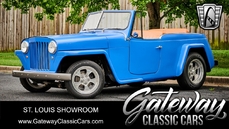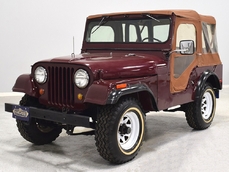Willys Jeep Pickup 1960
Allgemeine Beschreibung :
The civilian Willys pickup truck may not be as ubiquitous as the Jeep CJ Universal Utility Vehicle, but it is nonetheless a significant machine that laid the early foundation for America’s love affair with the pickup truck. After World War II, Willys Overland was quick to capitalize on the “war hero” status of the Jeep, first with the CJ, later expanding the line to include pickups and utility wagons. When introduced to the consumer market in 1947, the Jeep Truck shared much of its underlying architecture and engine options with the Station Wagon, which itself was an extended version of the CJ. Customers could specify their pickup in 2wd or 4wd, with the availability of a cab & chassis model or utility stake bed. Initially, the 134 cubic-inch “Go-Devil” L-head four-cylinder engine was standard, and while it wasn’t much of a powerhouse, it was torquey and virtually bomb-proof, tried and tested in the harshest conditions imaginable during WWII. An equally robust 3-speed Borg-Warner T-90 backed the engine, and four-wheel-drive models got a two-speed transfer case. The 4WD models featured a 1-ton payload rating and the option of a power take-off which could operate a seemingly endless variety of specialized equipment for farming and industry.
Willys adopted an “if it ain’t broke, don’t fix it” approach for nearly all of the pickup’s eighteen-year production run, choosing to make subtle styling and mechanical improvements along the way. One of the most significant changes came in 1954, with the arrival of the 226 cubic-inch “Super Hurricane” L-head inline-six, designed by Continental and supplementing the four-cylinder F-head Hurricane engine. With 105 horsepower and 190 ft-lbs of torque at 1400 rpm, the additional power made the Jeep pickup much friendlier and more versatile for everyday use. Like the mechanical layout, the styling borrowed heavily from the classic Jeep CJ, with its iconic vertical grille, inboard round headlamps, and flat fenders. There was no doubting its utilitarian purpose, but it also had a particular tough-guy charm that continues to captivate enthusiasts today. In its original form, the Willys Jeep Truck lasted through 1964, yet its DNA lives on today, serving as the inspiration for the long-awaited revival of the Gladiator pickup in 2020.
This 1960 Willys Jeep Model 6-226 Pickup is a beautifully restored example, equipped with the desirable Super Hurricane inline-six and four-wheel drive. Finished in a bold red and white color scheme, this truck is crisply presented with excellent detailing and an authentic, period-correct aesthetic. The all-steel body is in superb order, including the bed floor, which often takes the most abuse, but in this case, presents in excellent condition. Paintwork is similarly excellent, appearing glossy and smooth, with just a couple of minor dust marks noted on close inspection. Bumpers are painted black, while the chrome (consisting of headlamp rings, door handles, and a few flashes of body trim) is all in well-preserved original condition. White painted steel wheels with period correct 7.00-16 off-road tires complete the rugged look.
Like the CJ, Willys designed the pickup as a serious tool for work, so only the necessities are found in the two-passenger cab. The hard-wearing seat upholstery, door panels, and armrests of this truck appear to be in incredibly well-preserved original condition. The molded, Willy’s-branded rubber floor mat is in similarly excellent condition, showing little wear. Original switchgear operates the lights, wipers, heater, and choke, with anything else being a frivolous luxury.
Underhood presentation is tidy, with the Super Hurricane inline-six presented in good condition with authentic colors and fittings. The engine shows some light signs of use, such as flaking paint finish on the engine block and manifolds, while modern-style hose clamps point to routine service and care. Accessories include a correct oil bath air cleaner and Fram filter canister, and details such as the coolant sticker and Willard battery label provide round out the pleasing and authentic appearance. The chassis and undercarriage are similarly well-detailed, with gloss black chassis paint on the frame, axles, and suspension components.
We seldom encounter these trucks unmodified and so nicely restored, and this beautiful example is ideal for the serious Jeep collector or any enthusiast of classic trucks and off-roaders in general. This American legend is sure to delight its next caretaker for years to come.
Offers welcome and trades considered
https://hymanltd.com/vehicles/6515
1960 Willys Jeep Pickup is listed verkauft on ClassicDigest in St. Louis by Mark Hyman for $49500.
Fakten der Auto
Karosserietyp : Auto Marke : Willys Modell : Jeep Ausführung : Pickup Hubraum : 0.0 Modelljahr : 1960 Karosstyp : Pick up Lage : Missouri
Verkauft
Angaben Zum Verkäufer
Verkauft
People who viewed this Willys Jeep also viewed similar Willys listed at ClassicDigest
Other cars listed for sale by this dealer
über Willys
Die Willys-Overland Company, später einfach Willys genannt, war ein amerikanischer Automobilhersteller, der eine bedeutende Rolle in der Automobilgeschichte spielte. Hier ist ein Überblick über die Geschichte von Willys:Frühe Jahre:
Gründung: Das Unternehmen wurde 1908 von John North Willys in Toledo, Ohio, zunächst als Willys-Overland Motor Company gegründet. John Willys erwarb die Overland Automotive Division der Standard Wheel Company, die das Overland-Automobil herstellte.
Früher Erfolg: Willys-Overland war in den frühen 1910er Jahren erfolgreich und produzierte Fahrzeuge wie das Overland Model 79, das aufgrund seiner Erschwinglichkeit und Zuverlässigkeit ein beliebtes Auto war.
Erster Weltkrieg:
Militärverträge: Während des Ersten Weltkriegs sicherte sich Willys-Overland bedeutende Verträge zur Lieferung von Fahrzeugen für die Kriegsanstrengungen. Die Produktionskapazitäten des Unternehmens waren für das Militär von entscheidender Bedeutung, da es Lastkraftwagen und Automobile für verschiedene Zwecke herstellte.
Einführung des Jeep:
Beitrag zum Zweiten Weltkrieg: Im Vorfeld des Zweiten Weltkriegs reagierte Willys-Overland zusammen mit anderen Automobilherstellern auf die Anfrage der US-Armee nach einem leichten, geländegängigen Aufklärungsfahrzeug. Das Unternehmen entwickelte den Willys MB, der zum legendären Jeep wurde.
Jeep Legacy: Der Jeep spielte mit seiner Robustheit, Vielseitigkeit und Zuverlässigkeit eine entscheidende Rolle im Zweiten Weltkrieg. Sein Erfolg führte zur Gründung der Marke Jeep, die für die Herstellung von Geländefahrzeugen bekannt ist, die sowohl im militärischen als auch im zivilen Bereich an Popularität gewannen.
Die Nachkriegszeit:
Zivile Jeep-Modelle: Nach dem Krieg führte Willys zivile Versionen des Jeeps ein, wie die CJ-Serie (Civilian Jeep), die eine Adaption des Willys MB aus Kriegszeiten darstellte. Diese Fahrzeuge wurden für den Offroad- und Freizeitgebrauch beliebt.
Willys' Entwicklung und spätere Jahre:
Eigentümerwechsel: Willys-Overland geriet in finanziellen Schwierigkeiten und wechselte in den Nachkriegsjahren mehrmals den Eigentümer, bis es schließlich zur Kaiser-Jeep Corporation wurde, nachdem es in den 1950er Jahren von Kaiser Motors übernommen wurde.
Ende von Willys: 1970 erwarb die American Motors Corporation (AMC) Kaiser-Jeep. Das Willys-Namensschild verschwand allmählich, als sich AMC auf die Marke Jeep konzentrierte. Später erwarb Chrysler in den 1980er Jahren AMC und führte die Produktion und Entwicklung von Jeep-Fahrzeugen fort.
Vermächtnis:
Willys‘ Vermächtnis ist in erster Linie mit seinem Beitrag zur Automobilindustrie durch die Schaffung des Jeeps verbunden, eines Fahrzeugs, das die Mobilität während des Zweiten Weltkriegs veränderte und zu einer eigenständigen Kultmarke wurde. Der Ruf des Jeeps für Langlebigkeit, Vielseitigkeit und Geländetauglichkeit entstand durch die Innovationen und den Erfolg von Willys-Overland während des Krieges.











